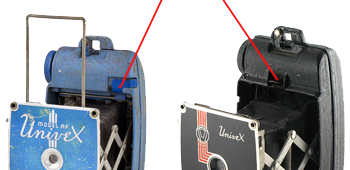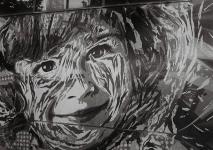|
Universal Univex AF-4 |
Manufactured or assembled in USA from (Before) 1939 to (Before) 1940.
Index of rarity in France: Rare (among non-specialized garage sales)
Inventory number: 4648
See the complete technical specifications
Chronology of cameras Universal
During 1935, several brands offered inexpensive cameras made of Bakelite. This was the case with the Kodak Jiffy and Bullet, priced at 3 and 6 dollars respectively, as well as the Argus A, priced at 10 dollars.
 En avriil, Universal annonce l'Univex AF. Il est décrit « Comme l’unique appareil Vest Pocket Camera tenant vraiment dans une poche" et il est le seul folding jamais vendus au prix de 1$.
En avriil, Universal annonce l'Univex AF. Il est décrit « Comme l’unique appareil Vest Pocket Camera tenant vraiment dans une poche" et il est le seul folding jamais vendus au prix de 1$.
The patent (No. 2,164,061) was filed on July 12, 1935, by Universal. The inventors are Otto W. Githens and Norden Jesse.
Like its predecessor, the Model A, it uses a specific film, the 00.

The camera body is made of enameled aluminum. The only adjustment available is the choice between instant (Snap) or time exposure (Time). The hidden tripod behind the facade unfolds downwards, and a sliding metal frame upwards forms the front part of the viewfinder.
Five colors are available: light blue, light green, gray, brown, or black. The blue and green models were much less produced because the majority of male customers preferred the other three colors.
In addition to the "standard" AF, there are special versions such as The Hollywood, a model for Girl Scouts, and a confidential G.E. Toppers Club Convention model, manufactured for a General Electric convention in 1936.
In 1936, on the new Univex AF-2 model, the hook that holds the bellows in the folded position moves towards the middle.


The back is equipped with a hinge. The front face is black adorned with a red Art Deco-style stripe. It is sold for $2.50. The AF-2 also has its special versions: The Hollywood (1938), Girl Scout (1937), and Aristocrat (1938).
In the same year, the Univex AF-3 arrives with an oxidized silver front plate. It is equipped with a lens treated for color called Duo Achromatic.
In 1937, over a million AF cameras were sold. The new Univex AF-4 is identical to the AF-3, but the Duo Achromatic Lens marking disappears. Some units have an 8 mm diameter front lens, while others have a 5 mm one.
In 1938, the Univex AF-5 is painted with bronze vermiculated paint. It has a side viewfinder that facilitates horizontal use. The 60 mm Ilex Achromar lens is mounted in a large brass ring, and the front plate is brass.
The history of Univex A and AF cameras ends in 1940 due to the unavailability of 00 film, production of which by Gevaert in Belgium becomes impossible with the Nazi invasion.
| Years | Fermeture soufflet | Lens | ||
| AF |  |
1935 | Excentré | |
| AF |
 |
1935 | ||
| AF |  |
1935 | ||
| AF |  |
1935 | ||
| AF | (gris) | 1935 | ||
| AF The Hollywood | 1935 | |||
| AF Girl Scout |  |
1935 | Centré | |
| AF-2 |  |
1936 | ||
| AF-2 The Hollywood | 1938 | |||
| AF-2 Girl Scout | 1937 | |||
| AF-2 Aristocrat | 1938 | Centré | ||
| AF-3 |  |
1936 | Duo Achromatic | |
| AF-4 |  |
1937 | ||
| AF-5 |  |
1938 | Ilex-Achromar 60 mm |
|
The AF-4 is different from the AF-3 in terms of the lens. The inscription found on the AF-3 lens, "Achromatic Duo Lens," is absent here. It can be assumed that the AF-4 has only a single meniscus lens.

Interesting links or bibliography :
Add a link or element of bibliography, a picture taken with this camera, a picture of box or an ads about this camera
Your photos taken with the same camera:
Cameras from Ebay France (Universal) (Uploaded each 3 hours)








